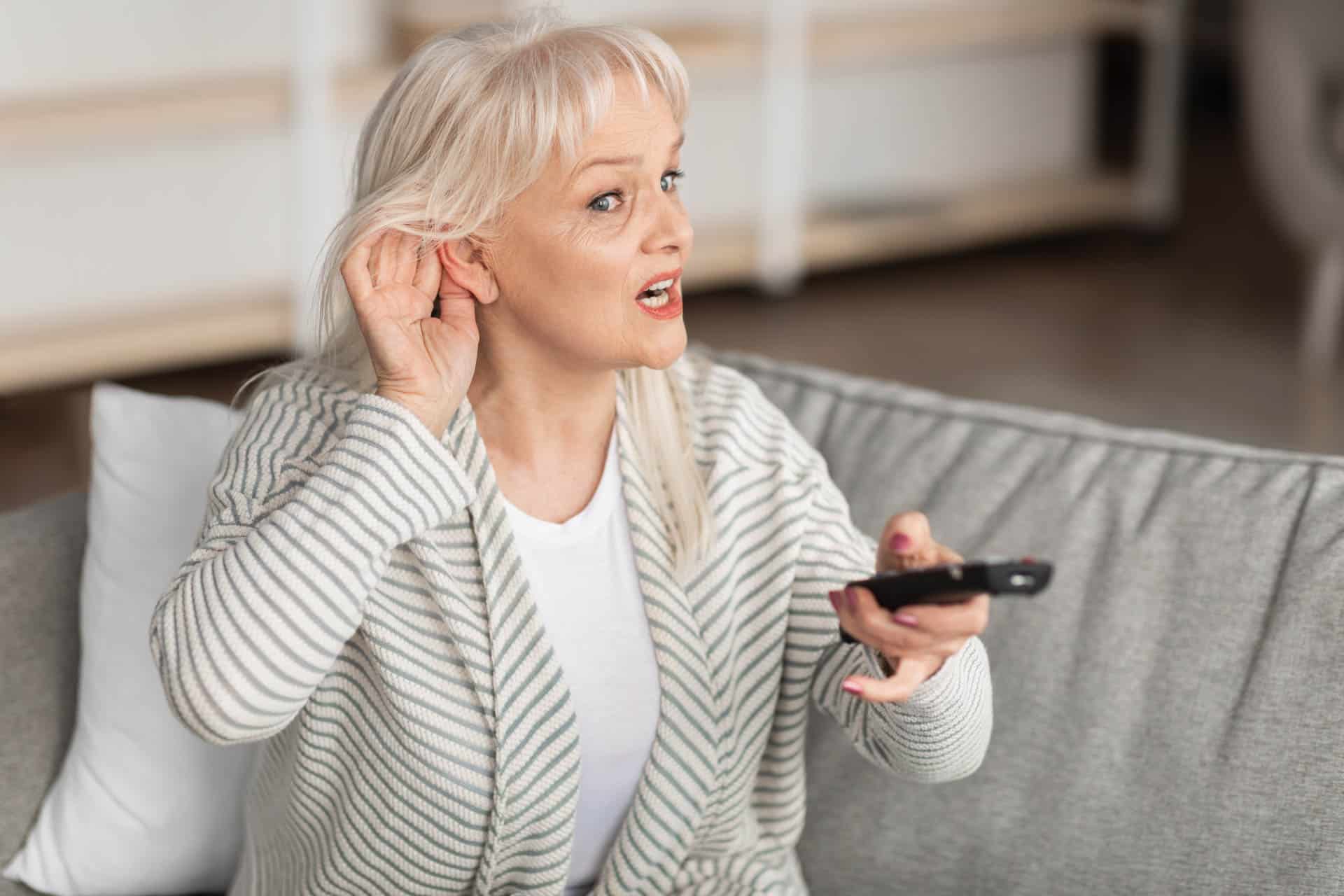Delivery in 2-3 working days
Television with hearing aid
Hearing aid wearers are familiar with the problem when watching TV: Sometimes it feels like you're guessing rather than hearing what's happening on the screen.
Hearing aids are small technical marvels that are designed to amplify and optimize the surrounding sounds. When watching TV, however, there is often a collision of sound worlds - the dialog from the TV competes with the ambient sounds of the room. For many people, watching TV with hearing aids is more of a challenge than a relaxation.
Find out below how you can enjoy watching TV to the full despite hearing aids. From the Bluetooth connection to the TV adapter to the TV sound amplifier, you have various options for adjusting the sound of your TV to your hearing aid. Find out more below.
Basics for watching TV with a hearing aid
How hearing aids work
Hearing aids are complex technological devices designed to improve or restore hearing. They work by picking up sound waves from the environment, digitally amplifying and modifying them, and then directing the amplified sound into the wearer's ear. Modern hearing aids can automatically adapt to different listening environments.
Types of hearing aids
There are different types of hearing aids. The best-known manufacturers include Oticon, Signia, Widex and Phonak, for example. Hearing aids can vary in size, shape, functionality and the way they process sound to provide optimal support for the wearer. Some are almost invisible in the ear canal, while others are worn behind the ear. Whether Oticon, Signia, Widex, Phonak or other manufacturers, each model also offers different functions and features, such as wireless connectivity, directional microphones or tinnitus-relieving technologies. Here, too, the individual wishes of the wearer play a role.
It is important to note that not all hearing aids are compatible with all types of additional devices or hearing aids, such as certain televisions or Bluetooth devices. This can be a challenge if users want to use special functions or connections. It is therefore important to check compatibility with existing or planned devices before purchasing a hearing aid. Expert advice from a hearing care professional can help you find a hearing aid that not only meets your hearing needs, but also your technical requirements.
Technology of modern televisions in terms of sound quality
Televisions today are no less diverse in terms of their function and technology. Modern televisions are equipped with advanced audio technologies that deliver clear and dynamic sound quality. Many models offer features such as Dolby Atmos, surround sound systems and customizable audio settings.
These technologies are designed to create an immersive listening experience, but can be problematic for hearing aid wearers if the sound is not optimized for their specific needs. Some televisions therefore offer special settings or additional devices to make it possible to watch TV with hearing aids.
Watching TV with a hearing aid: these options are available
Watching TV with a hearing aid or connecting a hearing aid to your TV may seem complicated at first glance. However, with the right technology, watching TV with a hearing aid is very easy, even in great quality. There are various methods - from special audio settings, direct cable connections or modern wireless solutions to TV adapters or TV sound amplifiers that you can simply take with you to your listening position as portable TV speakers.
Audio settings for hearing aid wearers
Modern televisions offer extensive audio settings that allow the volume and sound to be individually adjusted. Hearing aid wearers should take the time to try out different settings to achieve the optimum audio output. Adjusting the bass and treble settings, for example, can significantly improve speech intelligibility.
In addition, individual hearing programs that are tailored to the specific needs of hearing aid users can be helpful. Such programs make it possible to adjust the television sound so that it harmonizes optimally with the characteristics of the room and the hearing aid. These adjustments can often be made directly on the television set.
However, there are also disadvantages to using these special settings:
- Shared use:
If a television is used by several people, the settings specially optimized for hearing aid users may be less optimal for other viewers. - Individual differences in perception:
What is a clear and understandable audio setting for one person may be inadequate for another. This can be particularly challenging for hearing aid users with different types of hearing loss. - Complexity of the settings:
For users who are not familiar with the technology, setting the audio options on the TV set can be a challenge.
- Time required for fine-tuning:
Finding the optimum audio settings can be time-consuming, as it often takes several attempts and adjustments to achieve the best possible sound quality. - Depending on the quality of the TV set:
Not all TV sets offer the same range of audio adjustments. In some cases, the available settings may be limited, which restricts the options for optimizing the sound for hearing aid users.
Bluetooth connectivity: connect hearing aid to TV
One of the most popular and convenient ways to connect your hearing aid to the TV is via Bluetooth. Some modern hearing aids and TVs are equipped with Bluetooth, which enables a wireless connection between hearing aid and TV. You can stream the sound directly into your hearing aid, which means you can adjust the volume individually without disturbing other viewers.
However, the Bluetooth connection also has a few disadvantages when watching TV with hearing aids:
- Unstable connections:
Occasional interruptions or delays in the sound may occur. - Limited range:
The need to stay close to the TV to ensure a constant connection. - Higher battery consumption:
More frequent charging or battery replacement of the hearing aid may be necessary.
- Compatibility issues:
Not all hearing aids and televisions support Bluetooth or are compatible with each other. - Isolation:
Streaming sound directly into the hearing aid can result in less awareness of the surroundings, which can lead to a certain degree of isolation.
Alternative connection options: TV Adapter, TV Streamer, TV Connector
If your TV or hearing aid does not have Bluetooth, don't worry! There are other options, such as TV adapters, streamers or connectors, which act as a bridge between your TV and hearing aid. Many of these devices can be adjusted to your hearing needs and offer various connection and transmission options, for example via radio or infrared.
However, there are also a few potential disadvantages that users should be aware of:
- Compatibility issues:
Not all TV adapters are compatible with all hearing aid types or models. This can be problematic for users who already own a hearing aid and find that it cannot be paired with available TV adapters. - Additional setup and maintenance:
Installing and setting up a TV adapter requires a certain amount of effort. This could be a problem for people who are not technically experienced. - Audio transmission delays:
In some cases, there may be a minimal delay between the picture on the TV and the sound transmitted via the hearing aid, which may affect the viewing experience.
- Restricted mobility:
When using the TV adapter, freedom of movement may be restricted, especially if the adapter requires a physical connection to the TV. - Energy consumption:
Some TV adapters can increase the battery consumption of the hearing aid, resulting in more frequent battery changes or recharging. - Isolation from the environment:
The direct transmission of television sound to the hearing aid can lead to users hearing less of their surroundings, which could be problematic in certain situations and limit social interaction.
Wireless headphones
Special wireless headphones for the hearing impaired, such as chin-strap headphones, are also a way for hearing aid users to understand television better again. However, they have a clear disadvantage: they often cannot be used at the same time as a hearing aid. The hearing aids must therefore be removed from the ears before the headphones can be used, which can be cumbersome and annoying in the long term.
Other disadvantages of wireless headphones when watching TV with hearing aids are:
- Wearing comfort:
Wireless headphones, such as chin-strap headphones, can cause discomfort during prolonged use due to their weight or pressure on the jaw and ears. - Perception of background noise:
When wearing wireless headphones, everyday noises, such as the rustling of clothing, can be perceived more strongly.
- Isolation:
Using headphones while watching TV with family or friends can lead to social distancing. Wearers may feel isolated from conversations and interaction with others. - Poorer sound:
Although headphones usually increase the volume, they do not necessarily improve the sound quality.
TV hearing amplifiers: Portable TV speakers for hearing aid wearers
TV hearing amplifiers such as the OSKAR from faller audio offer a great alternative to TV adapters, connectors or the direct Bluetooth connection between hearing aids and televisions. While hearing aids are essential for many people with hearing loss, they are not always the best solution for watching TV as they are primarily designed to amplify speech and ambient noise. The OSKAR TV hearing amplifier, on the other hand, has a special technology that amplifies dialog on television and filters out disturbing background noise. This makes it a helpful addition when watching TV with a hearing aid.
The OSKAR is also compatible with all standard TV models that have an optical digital audio output or a 3.5 mm audio output (jack). This means that it can be easily connected to almost any TV. In addition, the hearing system can be connected to any other device that has one of these connections (e.g. PC, tablet, radio, CD player).
Tips for watching TV with hearing aids
Watching TV can be a challenge for people with hearing problems. We would therefore like to give you a few additional useful tips that can improve watching TV with hearing aids:
- Have your hearing systems individually adjusted by a hearing care professional:
It is important that your hearing aids or assistive listening devices are optimally adjusted to your individual needs. A visit to a hearing care professional can help to adjust your hearing aids so that they are specifically optimized for use while watching TV. - Use special TV hearing aids:
In addition to your hearing aids, you can use special TV hearing aids such as the TV hearing amplifier OSKAR . It helps to make dialog clearer and easier to understand by reducing background noise and improving speech intelligibility. - Use the settings on your TV:
Many modern televisions offer special settings that improve speech clarity. These settings can be particularly useful to increase the intelligibility of dialog for the hearing impaired. - Use "Clear language":
Since 2022, some TV channels such as Das Erste as well as some regional programs have been offering an additional audio track called "Klare Sprache". This audio track, which runs parallel to the original audio track, has been technically edited to make the speech easier to understand.
- Use subtitles:
Subtitles are an excellent support for people with hearing problems. They make it possible to follow what is happening on the screen, even if the sound quality or speech intelligibility is not optimal. - Pay attention to positioning and room acoustics:
The positioning of the TV set and the acoustics of the room play an important role when watching TV with a hearing aid. Make sure that your TV position is acoustically favorable and avoid places with strong noise pollution or echo effects. - Have your hearing systems serviced and adjusted regularly:
Make sure that your hearing aids and hearing aids are serviced and checked regularly. Good maintenance by a hearing care professional guarantees that your devices work optimally.



